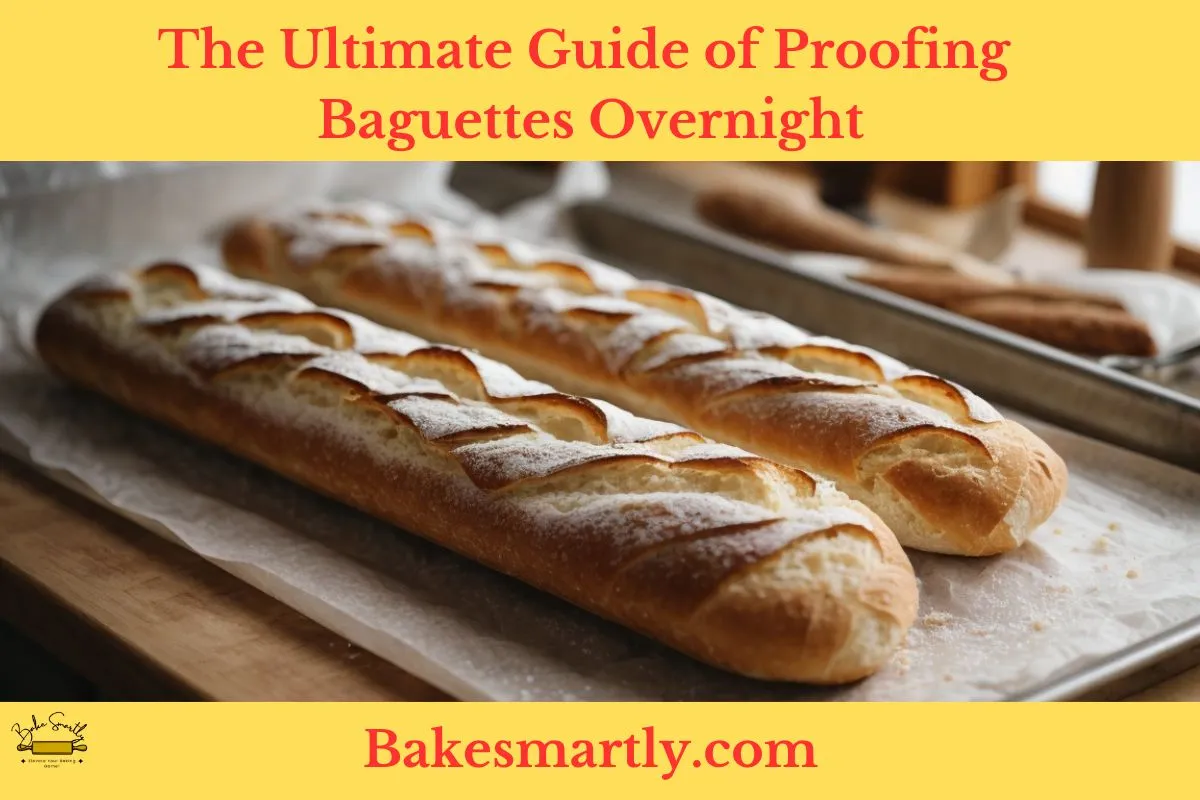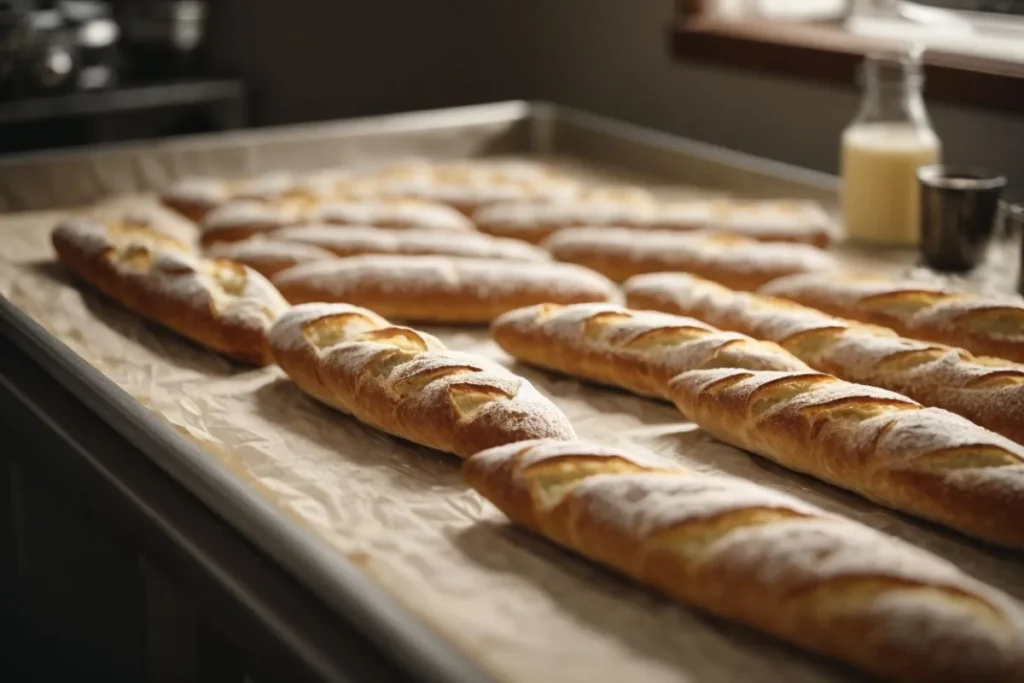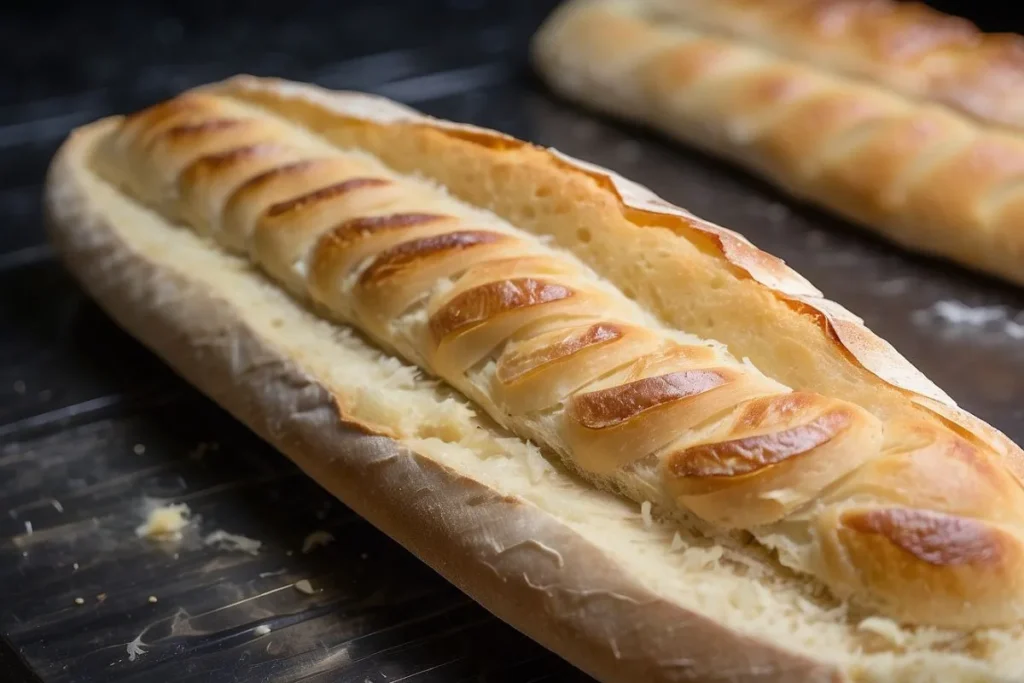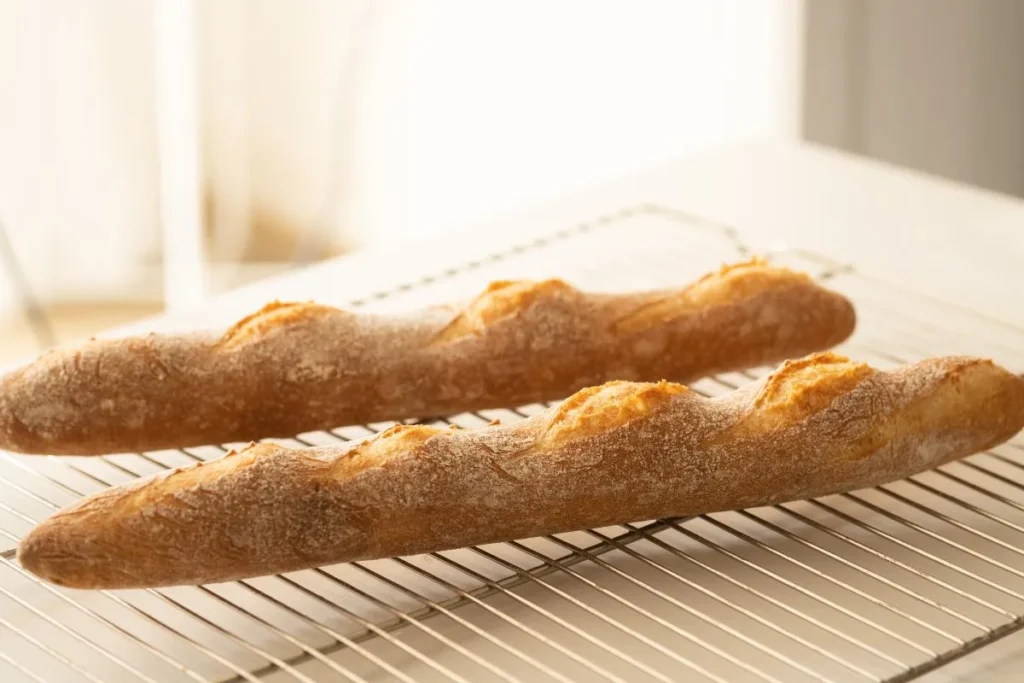
The Ultimate Guide of Proofing Baguettes Overnight
Are you tired of waiting hours for your baguettes to rise? Well, we’ve got the solution for you! In this article, we’ll spill the secrets to mastering the art of proofing baguettes overnight. By using this trick, you can enjoy fresh, crusty baguettes without the time-consuming steps.
With our easy-to-follow instructions and pro tips, you’ll learn how to prep your dough the night before, letting it develop rich flavors while you catch some 😴Zz. We’ll walk you through shaping and scoring your baguettes, making sure they reach their full potential during the overnight proof.
Whether you’re a seasoned bread baker or a kitchen newbie, this technique will change the game for how you make baguettes.
Table of Contents
ToggleCan You Proof Baguette Overnight?
The cool thing about letting baguettes proof overnight is how it transforms the dough like magic. The answer to the question, “Can you proof a baguette overnight?” is a definite yes! Doing it overnight means letting the dough rise slowly in the fridge, making its flavor and texture way better.
This method is great because it easily fits into your busy schedule and gives your baguette a fantastic taste and a crispy crust that sets it apart. When you give the yeast enough time and the right temperature, it slowly ferments, creating a perfect mix of flavors.
So, whether you’re a pro baker or just starting out, the simplicity of this process and the awesome results make overnight proofing a simple and rewarding way to make the perfect baguette.
Understanding the Process of Proofing Baguettes
Creating the perfect baguette starts with knowing how to proof the dough. This step is key in bread-making, where the yeast works its magic, turning basic ingredients into a symphony of flavors and textures.
Proofing is when the dough ferments, and the yeast produces carbon dioxide that makes the dough rise. For baguettes, it’s like an art form that needs precision and patience. It’s not just waiting around; it’s a delicate dance involving time, temperature, and ingredients.
As the yeast eats the sugars in the dough, it releases gases that get trapped, giving baguettes that airy, light inside. Finding the right balance between yeast activity and gluten development is crucial. Too little proofing time can make the texture dense, while over-proofing can lead to a too airy and fragile crumb.
Proofing baguettes becomes even better when done overnight. This longer time lets the fermentation happen slowly and in control, making the flavor and texture more intense. The dough gets complex tastes, and the gluten structure matures, giving the chewiness you want.
Controlling the temperature is also super important. A slightly cooler environment during proofing slows down the fermentation, giving the baguette a deeper flavor. Getting the proof just right needs a keen eye and understanding what makes your dough unique.

Benefits of Baguette Overnight Proofing
Baguette lovers and baking fans are discovering the wonders of overnight proofing for several compelling reasons. This well-loved technique, often seen as a game-changer in the baking world, brings a range of benefits that take the humble baguette to new levels.
- One significant advantage of overnight proofing is the richer flavor it gives to the baguette. The extended fermentation lets the yeast work its magic slowly, breaking down complex sugars and creating deep, nuanced tastes. The result? A baguette with a flavor depth that’s hard to achieve with shorter proofing methods. Picture biting into a baguette that not only boasts the classic crusty exterior but also a complex, well-rounded taste that lingers on the palate.
- Additionally, overnight proofing enhances the baguette’s texture and crust. The longer fermentation period helps the dough develop more gluten, leading to a chewier and more elastic crumb. Meanwhile, the crust benefits from the extended exposure to moisture, achieving that perfect balance between crispiness and a soft interior. This textural harmony is what distinguishes a professionally baked baguette from a regular loaf.
- For home bakers, the convenience of overnight proofing is a noteworthy advantage. Allowing the dough to rest and rise overnight makes it easier to fit the baking process into your schedule. This is particularly beneficial for those with busy lifestyles, as it lets you enjoy freshly baked baguettes without the need to constantly tend to the dough throughout the day. Just prepare the dough in the evening, let it proof overnight, and wake up to a ready-to-bake masterpiece.
Step-by-Step Guide to Proofing Baguettes Overnight
In this section, I will share how you can proof a baguette perfectly overnight. Here’s a straightforward, step-by-step guide to help you master the art of overnight proofing.
- Get Your Dough Ready Start your baguette adventure by gathering top-notch ingredients. Choose bread flour for that perfect chewiness and go for good-quality yeast or sourdough starter for added depth of flavor. Mix the ingredients in a bowl, slowly adding water until you get a sticky dough.
- Knead Until It’s Smooth Transfer the dough to a lightly floured surface and knead for about 10 minutes until it becomes smooth and elastic. This activates the gluten, which gives your baguette its structure and texture.
- Let It Rest Put the kneaded dough back into the bowl, cover it with a damp cloth, and let it sit for an hour. This first rest lets the yeast and gluten do their thing, making the dough more workable.
- Shape Your Baguettes Divide the dough into equal portions, depending on how many baguettes you want. Shape each piece into a long, slender loaf, paying attention to the surface tension. A well-shaped baguette rises evenly during proofing.
- Prepare for Overnight Proofing Set up a clean, floured surface or use parchment paper on a baking sheet. Place the shaped baguettes on it, making sure they’re spaced apart. Loosely cover them with plastic wrap or a damp cloth to prevent a dry crust.
- Refrigerate Overnight The magic happens in the fridge. Put the prepared baguettes in for an overnight stay. The cold slows down fermentation, letting the flavors develop slowly.
- Morning Check-Up The next morning, eagerly check on your baguettes. They should have risen and developed a lovely texture. If not, give them a bit more time at room temperature to keep proofing.
- Preheat Your Oven Before baking, preheat your oven to around 450°F (230°C). The high heat is crucial for achieving that coveted golden crust.
- Score the Dough Use a sharp knife or razor blade to make diagonal slashes along each baguette’s surface. This adds a nice look and helps the dough expand during baking.
- Bake to Perfection Put the scored baguettes in the preheated oven and bake until they turn golden brown, usually around 20-25 minutes. The delightful aroma filling your kitchen is a sign of the tasty results.
- Cool and Enjoy Once baked, let the baguettes cool on a wire rack. Proper cooling is crucial for the interior to set properly. Resist the urge to cut into them right away – patience pays off in baking.
- Serve and Impress Finally, the moment of truth. Slice into your homemade baguettes and savor the fruits of your labor. The crust should be crisp, and the interior soft and airy, a perfect blend of flavors and textures.

Common Mistakes to Avoid During the Baguette Overnight Proofing Process
vernight proofing is a crucial part of perfecting your baguette-making skills, but even experienced bakers can run into some issues. To make sure your dough turns out just right, let’s go over four common mistakes to avoid when proofing baguettes overnight.
1. Spending Too Much Time Proofing
A common mistake when letting baguette dough rise overnight is thinking it needs more time than it really does. While a longer proofing period adds unique flavor and texture, going beyond the recommended time can lead to overproofing.
This results in dough that rises too much but lacks the desired structure. To avoid this, stick to precise timings, keep a close eye on the dough, and make sure it rises well without going into overproofing territory.
2. Ignoring Temperature Factors
Temperature is crucial during the overnight proofing process. Neglecting it can lead to unexpected results. If it’s too warm, the dough might rise too quickly, risking overproofing.
On the flip side, a cooler environment may slow down fermentation, resulting in underproofed baguettes with a dense texture. Finding the right balance is key. Aim for a cool room temperature or use the refrigerator, adjusting settings based on your specific conditions for optimal results.
3. Not Considering Humidity
Humidity is often overlooked during the baguette proofing process. High humidity can affect the dough’s consistency, making it sticky and hard to handle. On the other hand, low humidity might lead to a dry surface, affecting crust development.
Pay attention to your kitchen’s humidity levels. Adjust the flour-to-water ratio slightly if needed, and think about covering the dough with a damp cloth to maintain the ideal moisture balance.
4. Underestimating Dough Quality
The dough’s quality is crucial for the perfect baguette. Poor mixing, imprecise measurements, or using expired yeast can compromise the entire process. Use high-quality ingredients and measure each component precisely.
Mix the dough thoroughly to evenly distribute the yeast, promoting consistent fermentation. Investing time in these initial steps lays the groundwork for successful overnight proofing, contributing to the flavor and texture that make a superb baguette.

How Long Does it Take to Final Proof a Baguette?
The final proofing in making baguettes is super important because it decides how your bread will turn out – the feel, taste, and overall quality. Usually, it takes about 60 to 90 minutes to get through this stage. But that’s just a general suggestion, and a bunch of things can affect how long it takes.
Temperature is a big deal. Warmer spots speed things up, while cooler places mean it takes longer. The trick here is letting the dough rise as much as it can without going too far. If it overproofs, your baguette might end up sad and flat.
The kind of yeast you use and what’s in your dough also matter. If you’re using a slow-rise method or adding stuff like poolish or biga, be ready for a longer wait. These methods give your bread a more interesting taste but ask for some patience.
To make sure you’re on track, look for visual signs. The dough should roughly double, and if you poke it gently with a fingertip, there should be a little dent. Nailing the timing in this last proofing step is the secret to getting that perfect combo of a crispy crust and a light, fluffy inside in your homemade baguettes.
Frequently Asked Questions (FAQS)
How do you preserve baguettes overnight?
To keep your baguettes fresh, store them in a paper bag or wrap them in a kitchen towel. Avoid airtight containers, as they can lead to moisture buildup. If you anticipate a longer storage period, consider freezing the baguettes; just ensure proper wrapping to prevent freezer burn.
How do you soften baguettes the next day?
Revitalize day-old baguettes by preheating your oven to 350°F (175°C), lightly dampening the crust with water, and placing them in the oven for 5-10 minutes. Alternatively, microwave the baguette for 10-20 seconds. Both methods restore moisture, enhancing the texture and taste of your baguette.
Final Thoughts
In the baking world, getting the hang of proofing baguettes overnight is a game-changer. This method not only saves time but takes the flavor and texture to a whole new level. The magic happens as the dough ferments slowly in the fridge, resulting in a baguette with a rich taste and a crispy crust that really stands out.
There are a bunch of benefits: a more intense flavor, improved texture, and the added bonus of being flexible enough to fit into any busy schedule. The step-by-step guide makes the process easy, so it’s doable for both experienced bakers and those new to the kitchen.
It’s important to avoid common mistakes to get the perfect balance of time, temperature, and humidity. The final proofing stage, lasting 60 to 90 minutes, is key to achieving that sought-after crispy crust and light interior.
Whether you’re a baking enthusiast or just testing the waters in the bread-making world, overnight proofing is a straightforward and satisfying way to make the perfect baguette.
So, get ready to roll up your sleeves, follow the guide, and wake up to the smell of freshly baked artisanal baguettes that will impress even the most discerning taste buds. Happy baking!
Lindsey Mackenzie
About me
Hi there! I’m Lindsey Mackenzie, the founder of Bake Smartly. Baking has been my passion since childhood, growing up in my father’s bakery. With Bake Smartly, I’m excited to share my love for all things sweet and savory. Join me on this delicious journey as we whip up scrumptious treats and sprinkle joy into every bite!






